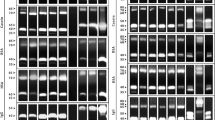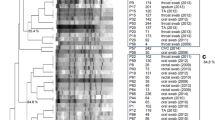Abstract
Production of secreted aspartate proteinases was determined in a set of 646 isolates ofCandida and non-Candida yeast species collected from 465 patients of theUniversity Hospital in Olomouc (Czechia) in the period 1995–2002, andCandida samples obtained from 64 healthy volunteers using solid media developed for this purpose. Using random amplified polymorphic DNA analysis (RAPD) 79Candida isolates from blood were analyzed to show potential relationships between clustering of the fingerprints and extracellular proteolytic activity of these strains.C. albicans, C. tropicalis andC. parapsilosis possess always proteolytic activity while non-Candida species did not display any proteolysis. A tight relationship between fingerprints and extracellular proteolysis in theCandida isolates was not shown. A remarkable consistency between fingerprint clusters and proteolysis occurred in a subset ofC. parapsilosis samples. Suboptimal pH of the growth medium was shown to facilitate the investigation of potential co-incidence of genotypic and phenotypic traits.
Similar content being viewed by others
References
Ausubel F.M., Brent R., Kingston R.E., Moore D.D., Seidman J.G., Smith J.A., Struhl K. (Eds):Current Protocols in Molecular Biology. John Wiley & Sons, New York 1994.
Bostock A., Khattak M.N., Matthews R., Burnie J.: Comparison of PCR fingerprinting, by random amplification of polymorphic DNA, with other molecular typing methods forCandida albicans.J.Gen.Microbiol. 139, 2179–2184 (1993).
Cormican M.G., Pfaller M.A.: Epidemiology of candidiasis.Compr.Ther. 21, 653–657 (1995).
Dorko E., Jautová J., Tkáčiková L’., Wantrubová A.: The frequency ofCandida species in onychomycosis.Folia Microbiol. 47, 727–731 (2002a).
Dorko E., Pilipčinec E., Tkáčiková L’.:Candida species isolated from cerebrospinal fluid.Folia Microbiol. 47, 179–181 (2002b).
Dorko E., Pilipčinec E., Tkáčiková L’.: Candidal urinary tract infections caused by non-albicans Candida species.Folia Microbiol. 47, 182–184 (2002c).
Dorko E., Pilipčinec E., Tkáčiková L’.: Fungal diseases of the respiratory tract.Folia Microbiol. 47, 302–304 (2002d).
Dostál J., Hamal P., Pavlíčková L., Souček M., Ruml T., Pichová I., Hrušková-Heidingsfeldová O.: Simple method for screeningCandida species isolates for the presence of secreted proteinases: a tool for the prediction of successful inhibitory treatment.J.Clin.Microbiol. 41, 712–716 (2003).
Douglas L.J.: Medical importance of biofilms inCandida infections.Rev.Iberoam.Micol. 19, 139–143 (2002).
Fridkin S.K., Jarvis W.R.: Epidemiology of nosocomial fungal infections.Clin.Microbiol.Rev. 9, 499–511 (1996).
Haynes K.: Virulence inCandida species.Trends Microbiol. 9, 591–596 (2001).
Hermann P., Forgács K., Gál E., Lenkey B., Nagy G., Rozgonyi F.: Effects of alkali metal ions on some virulence traits ofCandida albicans.Folia Microbiol. 48, 173–176 (2003).
Jautova J., Baloghova J., Dorko E., Pilipčinec E., Švicky E., Danko J., Tkáčiková L’.: Cutaneous candidosis in immunosuppressed patients.Folia Microbiol. 46, 359–360 (2001).
Kurtzman C.P., Fell J.W.:The Yeasts, a Taxonomic Study, 4th ed. Elsevier Science, Amsterdam (The Netherlands) 1998.
Marco F., Lockhart S.R., Pfaller M.A., Pujol C., Rangel-Frausto M.S., Wiblin T., Blumberg H.M., Edwards J.E., Jarvis W., Saiman L., Patierson J.E., Rinaldi M.G., Wenzel R.P., Soll D.R.:Elucidating the origins of nosocomial infections withCandida albicans by DNA fingerprinting with the complex probe Ca3.J.Clin.Microbiol. 37, 2817–2828 (1999).
McIntyre G.T.: Oral candidosis.Dent.Update 28, 132–139 (2001).
Neely A.N., Orloff M.M.: Survival of some medically important fungi on hospital fabrics and plastics.J.Clin.Microbiol. 39, 3360–3361 (2001).
Nguyen M.H., Peacock J.E. Jr.,Morris A.J., Tanner D.C., Nguyen M.L., Snydman D.R., Wagener M.M., Rinaldi M.G., Yu V.L.: The changing face of candidemia: emergence of non-Candida albicans species and antifungal resistance.Am.J.Med. 100, 617–623 (1996).
Nucci M.: Candiduria in hospitalized patients: a review.Brazil J.Infect.Dis. 4, 168–172 (2000).
Orozco A.S., Higginbotham L.M., Hitchcock C.A., Parkinson T., Falconer D., Ibrahim A.S., Ghannoum M.A., Filler S.G.: Mechanism of fluconazole resistance inCandida kruset.Antimicrob.Agents Chemother. 42, 2645–2649 (1998).
Pittet D., Wenzel R.P.: Nosocomial bloodstream infections. Secular trends in rates, mortality, and contribution to total hospital deaths.Arch.Intern.Med. 155, 1177–1184 (1995).
Rotman S., Sandovsky-Losica H., Sionov E., Segal E.: Effect of a chitin derivative in combination with cleaning and preservation solutions for contact lenses on adherence of fungi.Mycoses 46, 90–95 (2003).
Sanglard D., Ischer F., Bille J.: Role of ATP-binding-cassette transporter genes in high-frequency acquisition of resistance to azole antifungals inCandida glabrata.Antimicrob.Agents.Chemother. 45, 1174–1183 (2001).
Stewart K., Abad-Zapatero C.:Candida proteases and their inhibition: prospects for antifungal therapy.Curr.Med.Chem. 8, 941–948 (2001).
Tomšíková A.: Causative agents of nosocomial mycoses.Folia Microbiol. 47, 105–112 (2002).
Weig M., Gross U., Muhlschlegel F.: Clinical aspects and pathogenesis ofCandida infection.Trends Microbiol. 6, 468–470 (1998).
Wu T., Samaranayake L.P., Leung W.K., Sullivan P.A.: Inhibition of growth and secreted aspartyl proteinase production inCandida albicans by lysozyme.J.Med.Microbiol. 48, 721–730 (1999).
Author information
Authors and Affiliations
Corresponding author
Additional information
This work was supported by theMinistry of Health of the Czech Republic (grant no. NI/6485-3). The investigation of proteinases of the pathogenicCandida spp. is a part of a research conducted at theInstitute of Organic Chemistry and Biochemistry, Academy of Sciences of the Czech Republic. Prague (no. Z4 055 905).
Rights and permissions
About this article
Cite this article
Hamal, P., Dostál, J., Raclavský, V. et al. Secreted aspartate proteinases, a virulence factor ofCandida spp.: Occurrence among clinical isolates. Folia Microbiol 49, 491–496 (2004). https://doi.org/10.1007/BF02931614
Received:
Revised:
Published:
Issue Date:
DOI: https://doi.org/10.1007/BF02931614




